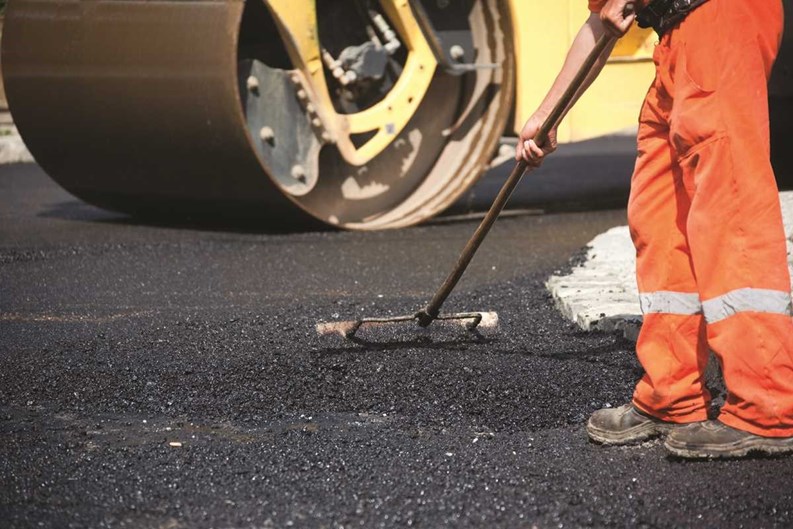The pavement you walk and drive upon daily is easy to take for granted—but it's a major part of your condo or HOA's infrastructure. Understanding the materials and methods involved in installing and maintaining a multifamily community's paved surfaces can save everyone a lot of hassle, time and money. Having some clue as to whether the asphalt parking lot just needs a patch job, a major renovation or total replacement can spare you unnecessary capital expenditures, and extend the useful life of your paving.
Firm Foundations
Knowing about paving means understanding the materials and methods used for such projects—but sometimes the correct material for the project may not be immediately obvious to everyone.
In Chicago communities, parking lots often are constructed of asphalt, while sidewalks, patios and the paving around balconies, decks and pools is often made of concrete. Asphalt is comprised of different-sized rock bits, sand and petroleum. It cures over a period of six months to a year. But strictly speaking, asphalt never really “sets up”—it stays flexible, unlike typical concrete, which becomes a solid, rigid surface after it cures.
Concrete is made of crushed stone, sand and cement, and often it is used for sidewalks and patios. The material also can be used for parking lots, although some communities choose to pave their parking lots and driveways with asphalt, because it is often less costly to install than concrete, and its aforementioned flexibility can more easily accommodate the weight of vehicles without cracking.
There are advantages to using each of the materials, including life span and maintenance. If installed correctly, concrete has a 20-year life span or even longer, while asphalt’s life often is shorter, and very much dictated by environmental conditions.
The Spall of the Wild
Early signs that concrete needs attention are tripping hazards like cracking and spalling (flaking of the material’s surface), and separation of slabs from each other along joint lines. “The first thing a layperson notices is a tripping hazard. The concrete starts to crack and spall, and it slowly starts to erode,” says Craig Frier, treasurer for the Chicago chapter of the International Concrete Repair Institute (ICRI), and a project manager at Sika Corporation. “We apply salt in wintertime, which creates pockmarks and eats away at the surface.”
Sealing the concrete with a sealant can alleviate this problem, as can applying a sealant to the concrete’s joints, Frier says.
Early signs regarding asphalt needing repair are relatively obvious. "The most common problems associated with asphalt include settlement at garages, rutting of traffic patterns in parking areas, and downspout drainage. Winter effects such as heaving asphalt causing elevation changes, standing water, proper elevation and grades, or cracked and broken asphalt are signs that the asphalt is deteriorating or in need of repair," says Richard DuBois, president of DuBois Paving, based in East Dundee, Illinois.
Part of what wears asphalt down are the elements—cold, rain, snow and heat. Asphalt becomes deformed through expansion and contraction, but in colder or hotter climes the stresses on the material can be tougher. In summertime, stress caused from heavy trucks can create ruts in the heat-softened asphalt, and cold weather can help create cracks, or worsen existing ones. Other factors such as oil dripping from vehicle engines can wear away at an asphalt surface over time and cause pitting.
“Vehicle traffic does take its toll,” says Jim Distasio, vice president of sales and marketing at Cicero-based M&J Asphalt Paving Company, Inc., in business since 1979. “You’d be surprised at how much, for example, garbage trucks wreak havoc on pavement, delivery trucks…Mother Nature. Those are a few of the external factors that cause the degradation, but ultimately, the issue could be structural, too. The sub base of the asphalt may be faulty, or if it’s failed…that failure is going to cause the drainage issue.”
Improper installation also can be a fatal problem for an asphalt surface. If the asphalt is not installed at the correct temperature, it won’t ever cure properly. Correct asphalt installation also includes applying a sealer to the surface. After the initial installation application, seal-coating should be repeated yearly to get the longest life out of the asphalt. Seal coats are usually either coal tar, or a petroleum-based product called asphalt emulsion sealer.
“With a paved surface, work with trustworthy and reliable contractors to create an annual maintenance plan, especially if you just had a new surface installed, to protect that investment…preserve what you have,” continues Distasio. “Every year, refresh with a seal coat, to seal the pavement…protect it from the elements, from water and oil from cars and vehicles. In warmer climates, you can get away with once every two years.”
Distasio explains what an effective and efficient maintenance plan involves. “It’s important to use seal coating and patching where necessary,” he says. “For asphalt surfaces properly installed, you can get upwards of 15 years, depending on the climate and if maintaining it very well. It will save you money in the long run, as opposed to doing it when there’s a problem.”
Without a doubt, DuBois concurs with his fellow industry experts on the value of catching problems early. “Being proactive with preventative maintenance early is a much better solution than reacting to problems,” he says.
While asphalt paving is usually less costly than concrete for new parking lots (though according to some industry sources, the materials are reaching parity now), when a community is on a tight budget and has an existing asphalt lot, it can make sense to repair or repave the parking lot in asphalt. But just because an existing asphalt lot is in bad shape doesn’t mean that the best solution is always to use more of the same. Sometimes an overlay of two inches of concrete atop the existing asphalt pavement delivers a superior result.
Regardless however, these are technical questions, and not something that a board member or manager who isn't a paving expert should address without professional input. Whether a paving contractor or hired engineer, when it comes to spending thousands of dollars on a new parking lot or on another large surface, board members should call on competent, trusted professionals to help them determine the right materials and approach for their particular project.
Noticing Cracks
It’s also important to recognize the signs that the paved surface is breaking down. If caught early, the problem could require a not-too-costly repair. If detected later, it might mean a total parking lot replacement, or a more costly drainage system and parking lot replacement.
As already noted, asphalt cracks when it is breaking down. Those initial surface cracks could quickly lead to a much more pervasive problem, because they allow water into the pavement's subsurface. In both concrete and asphalt, the subsurface is the foundation of the surface; if it is compromised, the entire paved area may need to be replaced. That’s why the exact nature of the paving problem and the precise fix for it must be devised by the engineer or another competent professional. Tempting as it might be to take a do-it-yourself (DIY) approach to repairing the issue, there's really no substitute for sound professional advice, and fixing the problem decisively, rather than in half-steps that can wind up costing more in the long run.
Another disadvantage of using asphalt pavement in a residential community is that asphalt paving traps more heat than concrete. It creates urban heat islands, which are 10 to 20 degrees hotter than surrounding areas. The sun bakes down on those paved areas because they retain heat.
Concrete paving—especially the traditional, impermeable kind that’s made of Portland cement—also is susceptible to water infiltration and the damage it causes. That’s why even small cracks or some “spalling”—when chunks of the surface of the concrete begins to flake off—must be repaired immediately.
Do It Right
Problems in an area of concrete paving could begin on the day of installation. A concrete mix must have the correct amount of water, or the batch could be weakened. On an especially hot day, though, cement trucks sometimes get caught in traffic while delivering a batch, and the truck driver continues to add water to make sure the batch is still usable. On a state or federal highway job where a worker is tasked with testing and approving (or nixing) each batch of cement, such a batch would be rejected. And contractors with scruples also will reject such a batch and wait sometimes hours more for a new batch to arrive.
But cement testers are pretty much unheard of on residential projects. That’s why it’s important for a board to have the community’s engineering consultant oversee paving jobs, and to ensure that the contractor chosen for the project is reliable, trustworthy, and stands behind his work.
“Scrimping on the sub base, or putting it on spongy ground can cause problems,” says Frank Jureske, owner of Fran’s Concrete in Dundee. “A lot of contractors will tear up a driveway and just put in a half-inch of concrete and pour it, when at least four inches are needed. That results in more cracking and settling.” Which is why it pays to know what, and whom, your community is paying for on the pavement job. “If you work with the cheapest guy, they’ll cost you money in the long run,” Jureske says.
All paved surfaces in the community must be overseen by the property manager and engineer, from installation and throughout their life spans. If the community is a professionally managed one, the property manager or the engineer should inspect all of the paving at least yearly. When these professionals aren’t doing this routine task, another professional could become involved—the community’s lawyer.
While legal penalties from the government for communities that don’t maintain their pavement are not common, lawyers who specialize in representing people who are injured from trip-and-fall hazards are around every corner. Liabilities for such injuries could financially devastate a community. For a community to be found liable, a lawyer need only prove the community’s management should have known of the hazard and should have corrected it. If the hazard was obvious and should have been noticed and corrected, the community will pay for it.
But seasonal maintenance steps can keep pavement in good shape. First, ensure that the drainage system taking water away from the pavement is clean and clear of debris, so it doesn’t back up with water. Parking lots must have debris removed and be swept clean. Landscaping around paved areas should be trimmed and disposed of, and a seal coating should be applied to the asphalt pavement if it is determined that it’s time for a treatment. Concrete is not seal-coated as regularly as asphalt and in some cases is not seal-coated at all.
Maintenance of concrete also could mean applying a urethane sealer, attending to caulking by replacing it, and fixing potential problems in joints. A sidewalk should be caulked every five years; if applying a sealer, it should be re-applied on the sidewalk for up to a 10-year life of the sidewalk. Sealants are basically waterproofing, since concrete is basically a big sponge.
Be aware of where the concrete needs to be re-caulked, along buildings and along curb lines, Jureske says. “Sometimes expansion joints between slabs need to be replaced or re-caulked,” he says.
In the end, your board/management team doesn’t have to be experts on paving to keep your community's surfaces safe, attractive, and functional—they just need to know the basics, seasonal maintenance tips, and who to call when a problem arises.
Jonathan Barnes is a freelance writer, who regularly contributes to The Chicagoland Cooperator. Associate Editor Blake French contributed to this article.







Leave a Comment